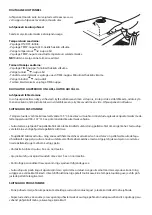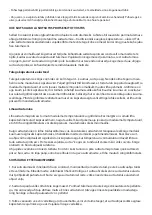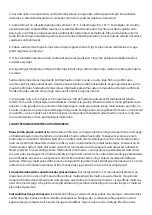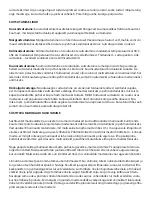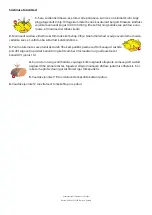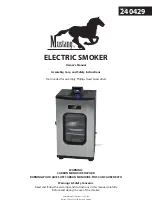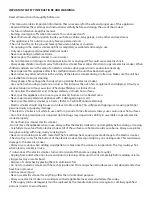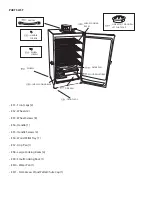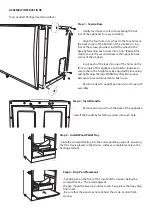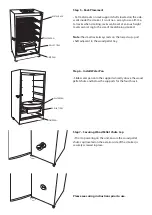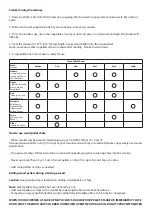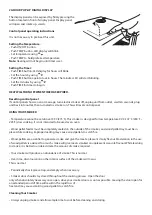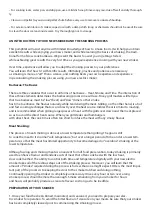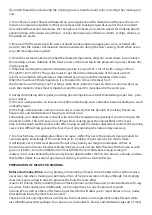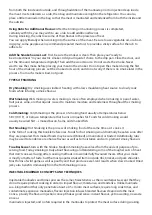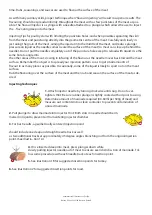
from both the inside and outside, and through addition of the marinade prior to injection deep inside
the meat. Use tenderizers as a rub, then bag and marinate overnight in the refrigerator. You can also,
place a little marinade in the bag so that the meat is marinated and tenderized from both the inside and
the outside.
Using Rubs for Additional Flavour: After the brining or marinating process is completed,
certainly with ribs, you may wish to use a rub to add additional flavour.
During smoking, the rubs lose some of their flavour in the presence of heat.
You can apply liberally when working into the surface of the meat. Be sure to use vegetable oil, or a bast-
ing spray, some people even recommend prepared mustard, to provide a sticky surface for the rub to
adhere to.
Add the Smoke Source Last: First, be sure the smoker is clean. Then place your “ready to
be smoked meat” in your electric smoker. Add your liquid of choice to the drip pan. Close the door, and
set the time and temperature digitally. Then add the wood source. Do not waste the smoke. Never
wait to see the smoke before placing your meat in the smoker. Do not open the smoker during the first
hour of the smoking process. Let the smoke do its work, and do not worry if there is no smoke later in the
process. Too much smoke is bad, not good.
TYPES OF SMOKING
Dry Smoking: Dry smoking uses indirect heating with a low smouldering heat source to slowly cook
foods while infusing a smoke flavour.
Wet Smoking: Wet smoking or water smoking is more often employed when smoking. A pan of water,
fruit juices, wine, or other liquids is used to maintain moisture and tenderness throughout the smoking
process.
Cold Smoking: Cold Smoking is the process of smoking food usually at temperatures below
38
˚C(
100˚ F), or below a temperature that burns or liquefies fat. Foods for cold smoking would
usually be cured first – smoked bacon, hams, and smoked fish.
Hot Smoking: Hot Smoking is the process of smoking food at the same time as it cooks. It
is the form of cooking this booklet references. Foods for hot smoking would normally be eaten soon after
they are prepared. Hot smoked foods may be cured (brined) or marinated, or basted. Additionally, rubs
may be used to tenderize or enhance flavour as well as to moisturize and com- plement smoky flavours.
True Barbecue Starts with the Smoke: Modern Smoking has evolved from the ancient purpose of pre-
serving food. Today smoking is truly about flavouring and tenderizing some of the tougher cuts of meat
that don’t cook well using other cooking methods into wonderfully flavoured meals. What you smoke
is mostly a matter of taste; but the most popular smoked items include ribs, brisket, and pork shoulder.
Most forms of wild game as well as poultry and fowl produce excel- lent results when slow smoked. Dried
jerky also benefits immensely from the Hot Smoking process.
INJECTABLE MARINADE CONCEPTS AND TECHNIQUES
Injectable marinades and brines possess the same characteristics as their counterparts except that they
do not require product soaking in order to impart flavour; moisturize, and tenderize. Unlike marinade
soa-k ing method that only penetrate about a 0.5 cm into meat surfaces, require long soak times, and
contaminate expensive marinades, flavour injection infuses blended flavours deep inside the meat.
Conce- p tually the flavour injection concept makes good sense: instant flavour, yet no waiting, no waste
since as
marinade is injected, and no fats required in the marinades to protect the meat surface during soaking

